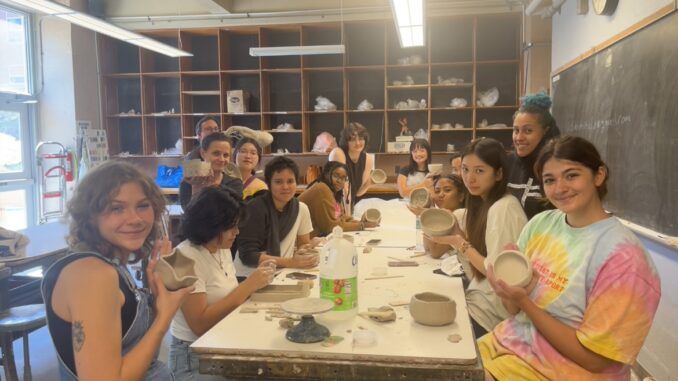
By Paulina Gajewski
From earthenware dishes stacked across shelves in department stores, to particularly placed porcelain in a grandmother’s kitchen cabinet, to sculptures littered across museums, pottery has shaped arts and cultures around the world.
Brooklyn College offers some courses relating to studio practice in ceramics, but students on campus can engage themselves with pottery in a lax environment outside of the classroom. A year ago, Angela Auriti, who is currently pursuing a BFA in art, revived the Brooklyn College Ceramics Club.
The once bustling club had ceased its efforts during the period of quarantine. A plethora of clubs on campus also faced the same issue, wondering how effective it would be to continue meetings on an online platform. Pottery, a tactile art that depends heavily on hands-on work, is work best left for an in-person environment.
“When we first started, I went to the involvement fair and had gotten over a hundred twenty signatures. Most of those people came for the first few weeks, but it really trickled down to a close knit group of people,” said club president Auriti, noting that larger numbers don’t indicate more success or passion and was glad that those who stayed really wanted to be there and make art.
Auriti, who started off as a film major, decided to pursue a different path after taking a painting class as an elective course. Clay, however, is a medium set apart from other physical art forms. She preferred a 3D artistic endeavor over 2D, or “flat” art.
Nana Santini, a member of the Ceramics Club and a student at BC pursuing childhood education with a concentration in art, notes that the community and environment above all is what makes the club special. “You want it to be a safe space,” she told The Vanguard. “When you are doing something for the first time and you have no real knowledge of it, you don’t want people to judge you. You want to enter a space where you can ask questions.”
The club starts off each semester with a syllabus, which outlines the different varieties of ceramics they hope to work on. This by no means signifies that creativity is diluted. The majority of the members in the room were working on pinch pots, in which students simply pinch clay into a desired shape. Though the same method was used across the room, not one piece of work was similar to another in design.
“There is no exact way to deal with clay,” said Elizabeth Li, who is pursuing a BFA in art. “I like to just go with the flow. But clay can be a little temperamental. You can’t let it be too dry or too wet. After you know the basic rules, you can turn off your brain and work.”
Arts, whether pursued professionally or as a hobby, are generally associated with the element of inspiration and entertainment. Members like Emily Nguyen, a marketing major at BC, appreciate that pottery is a hands-on activity and is a long process. “Today, we’re just pinching the clay, but during the next meeting we’ll have to fire it, and then the next meeting, we’ll paint. It’s exciting knowing there’s always a next step,” she said.
Pottery is not just defined by working with the medium of clay. Combined with science and technology, pottery can form not only aesthetic features, but functional ones as well. Theo Stewart-Stand, who is currently pursuing a masters in sculpture, is working on a water feature that combines the two. “I’m working on a bird with a sensor, and the front presents itself like a water fountain.” Steward-Stand hopes that the sculpture will be placed somewhere on campus once it is completed.
In the wake of COVID, clubs across campus lessened in numbers until their presences were severely diminished. At the beginning of the second full year back, these clubs are currently attempting to bring back the lively communities that once flourished on campus.
“It’s always important to find something to let your creativity out, and pottery is perfect for that,” Nguyen said. The Ceramics Club meets every Friday in Whitehead Hall 104.
